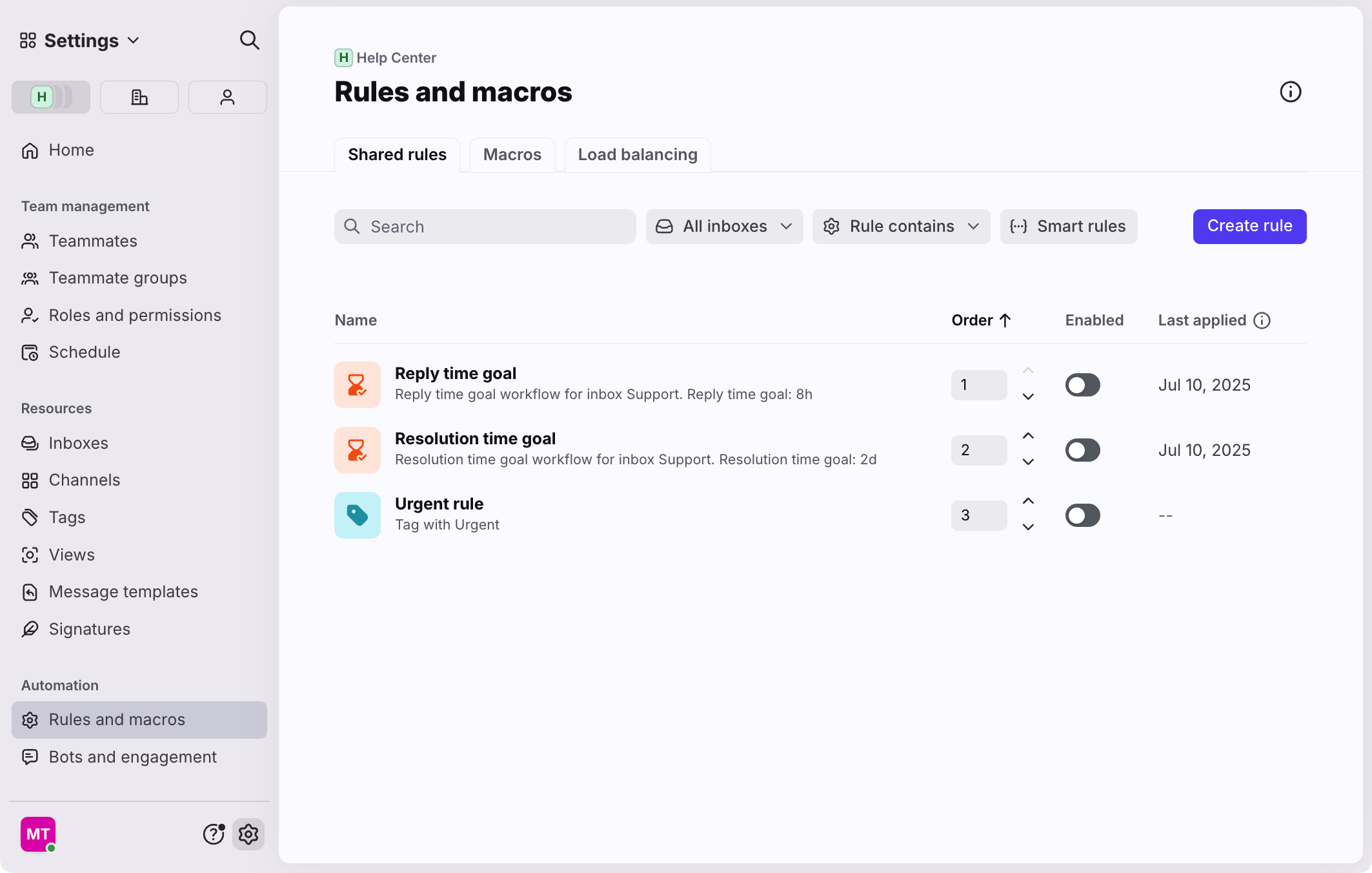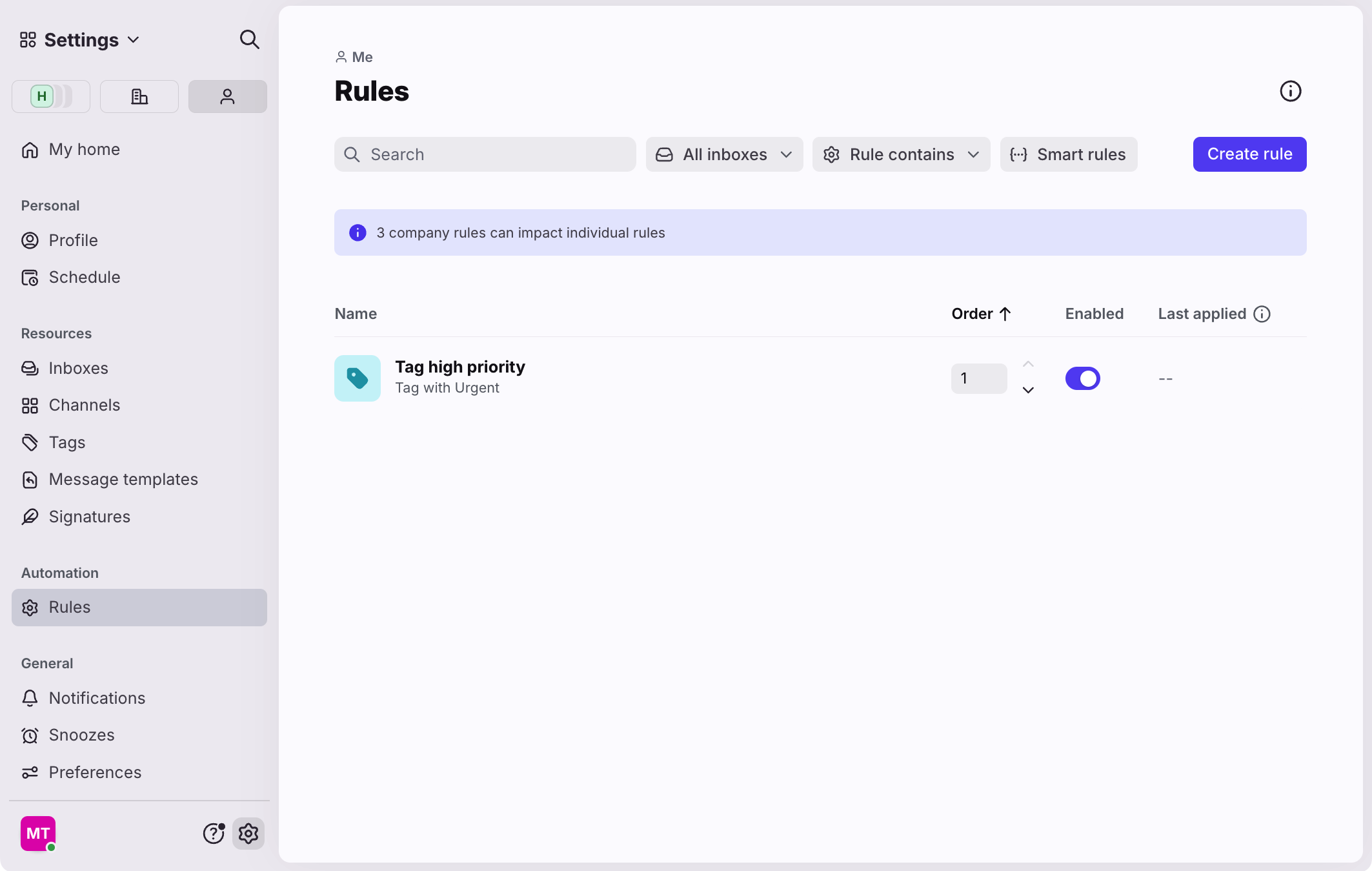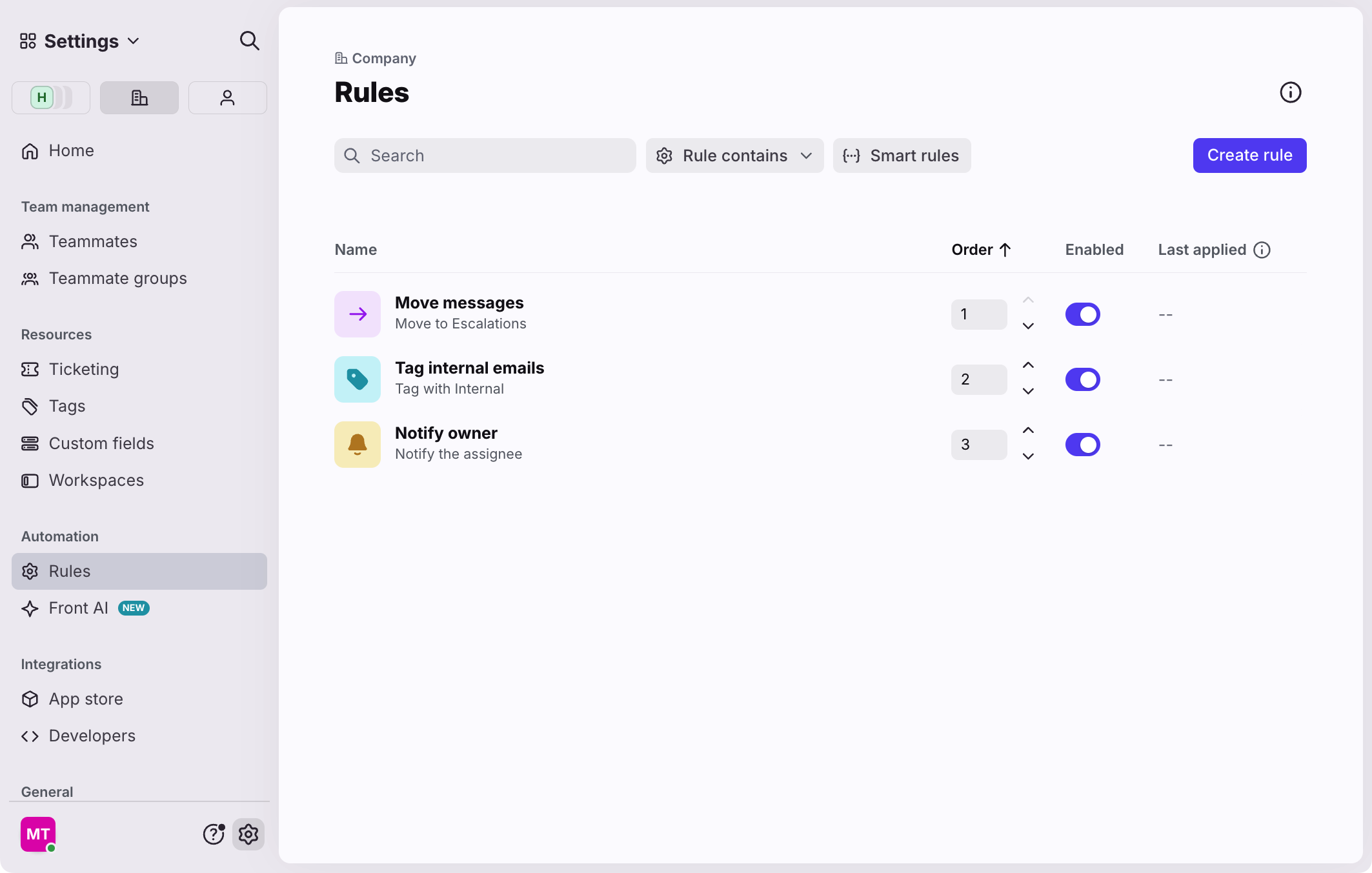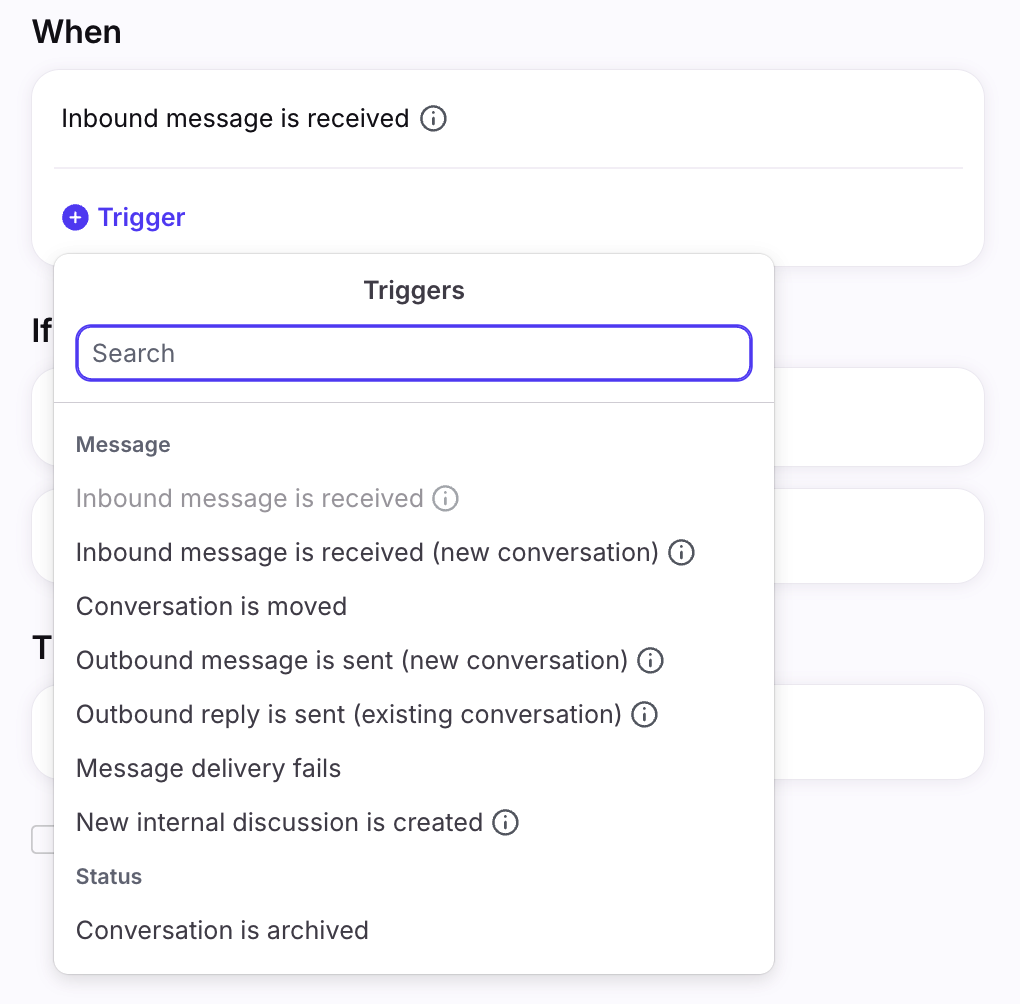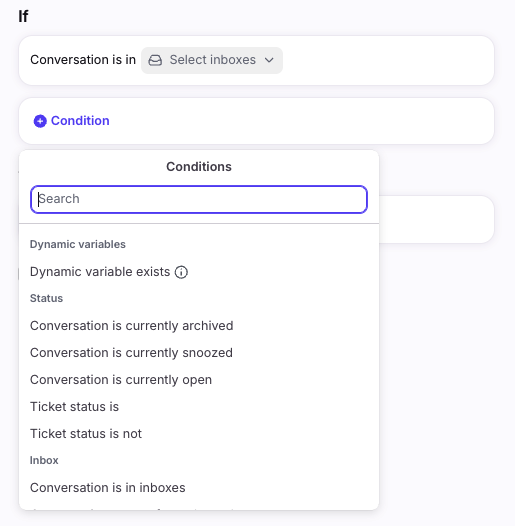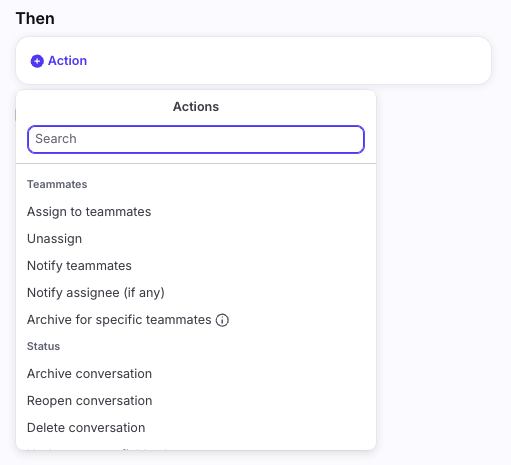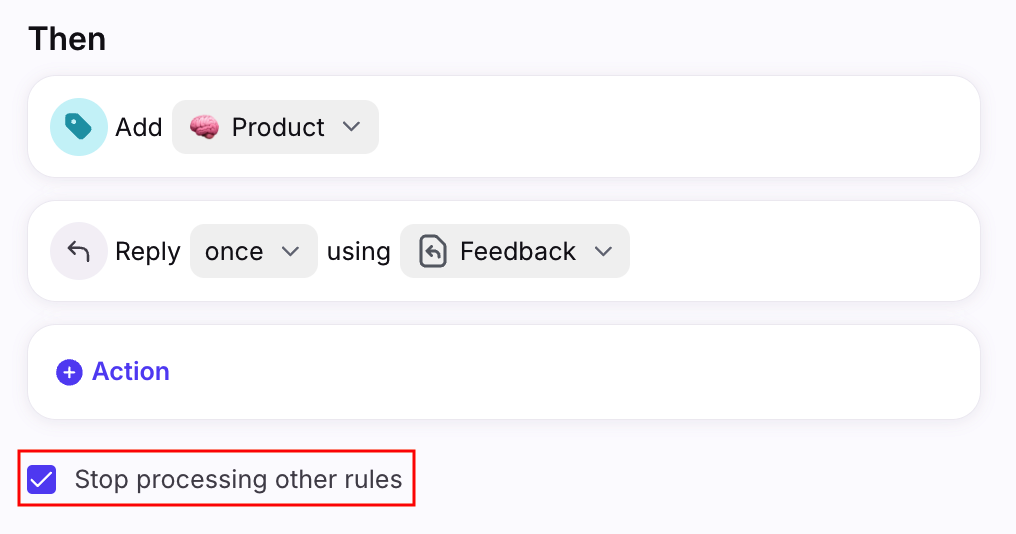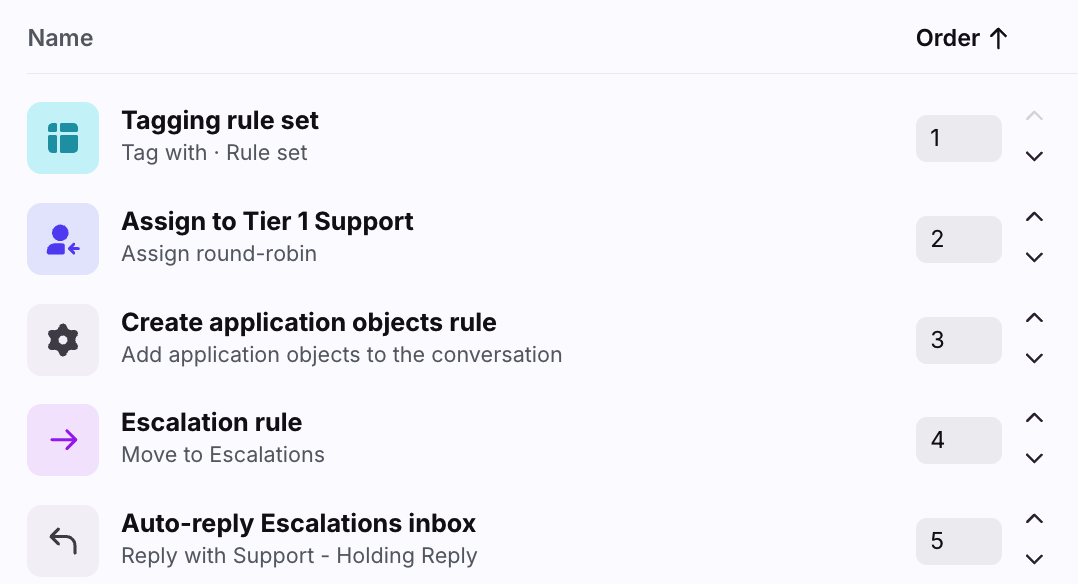Understanding rules
Overview
Use Front rules to automate your workflows, helping you handle repetitive tasks to save time and increase your team's efficiency in Front.
This article will help you understand how rules work. After reading, use our rule library to browse and automatically create rules for your team. You can also check out our guide to rule triggers, conditions, and actions and create a rule from scratch.
Take a Front Academy course here learn more about leveraging Front's rules to achieve your goals.
Rules fundamentals
Rule scopes
There are three kinds of rules: workspace rules, individual rules, company rules.
Workspace rules
Workspace rules are applied to any shared inbox and can only be created by workspace admins or company admins. Workspace rules can be accessed from the workspace settings tab in Rules and macros.
Individual rules
Individual rules will apply to your individual inbox. Your individual rules can be accessed from the Rules section in your Personal settings tab.
Company rules†
Company rules can apply to all individual and/or shared inboxes and can only be created by company admins. Company rules can be accessed by clicking Rules in the Company settings tab.
Parts of a rule
Rules are made up of three components: triggers, conditions, and actions.
See here for a full guide to rule triggers, conditions, and actions.
1. Triggers (When)
Triggers specify the types of events that will cause Front to start evaluating the conditions of your rule and see if they are met. Triggers can be done manually by a teammate or via Front's API.
2. Conditions (If)
Conditions are the criteria that determine whether a rule will be actioned on. More on how to use and/or statements in your conditions can be found in this article.
3. Actions (Then)
Actions specify the actions that will result when the rule is processed successfully (when all conditions are met). You have the option to check off Stop processing other rules to prevent the actions of a rule from triggering other rules.
Linear vs. branching rules
Front offers two types of rules to match your workflow complexity:
Linear rules follow a straight sequence: upon a trigger, when conditions are met, actions fire in order. Ideal for simple automation, they’re also the exclusive home for custom workflows like time goal rules, customer satisfaction (CSAT), quality assurance (QA), or chaining up to 500 similar rules into one (rule sets).
Branching rules let you define multiple action paths from a single trigger, depending on different scenarios. Perfect for configuring more dynamic workflows from a single place.
Not sure which to choose? Start with a linear rule, then upgrade to branching as your needs evolve.
Ordering of rules
You can set an order for your rules if you want certain ones to take priority over others. This means that the one ordered higher will have its actions take precedence, and the lower rule may only apply some of its actions so as not to conflict with the other. Delayed rules are special, in the sense that they will only be processed if the conditions are met at the designated time.
Type in the desired position of the rule, or use the arrows to the right of each rule, to adjust rules up or down the list.
Company rules will always have priority over individual or workspace rules and behave as if they were ordered before all other rules. Since company rules always execute first, they cannot be triggered by workspace rules.
Rules triggering other rules
Sequential rules
With Front's rule engine, an action of a rule can be used to trigger a subsequent rule, so you can build a sequence of rules to rule one after another. Here's an example sequence:
Rule #1
WHEN: Inbound message
IF: body contains "refund"
THEN: Add Finance tag
Rule #2
When: Conversation tagged
IF: Added tag is Finance
THEN: Assign to Andersen
Because Rule #1 is processed first, the Finance tag will be added. This will create a conversation tagged action, which allows for Rule #2 to be triggered. And because the Finance tag is present, the second rule is processed and the conversation is now assigned to Andersen.
Helpful to know:
The ordering of rules also applies to sequential rules, so any rules that you want to run sequentially should be ordered below the original rules you want to run.
Due to the sequential nature of Front's rule engine, a rule cannot trigger itself.
When conversations move across workspaces
You have the option to determine whether sequential rules continue to run when conversations move from one workspace to another, or when moving from an individual to a shared inbox. By default, the option to continue running the rules in the destination workspace will be turned on, but you can turn this setting off in each rule where you do not want it to run after it moves to another workspace. The setting is located in the rule's Then section — click the dropdown arrow next to your Move action to see the checkbox for Trigger rules when moved to another workspace.
In the destination inbox, the rule trigger that continues the sequence of rules would be WHEN: Conversation is moved. Other triggers (e.g. conversation is tagged, inbound message is received, etc.) that may match your rule definitions will not run.
For example, if you have the Trigger automated rules option checked:
Rule #1 in the original workspace or personal inbox
WHEN: Conversation is tagged
IF: Contact is in Finance
THEN: Move to inbox Billing*
*Billing inbox would be in the destination workspace that the conversation is moving to.
Rule #2 in the destination workspace
WHEN: Conversation is moved
IF: Inbox is Billing
THEN: Assign to a specific teammate Helena
Keep in mind that when the conversation moves to the new workspace, all rules in the destination workspace that have a trigger When conversation moved will attempt to scan for matching conditions, if those rules have the Trigger automated rules option checked. If all conditions match, then the actions of those rules will run. Multiple rules may run if there are no conflicting actions, so you’ll want to ensure that you define your rules to be specific to your intended conversations.
Option to stop processing other rules
If a rule is processed, and you don't want other rules listed below to apply, check the Stop processing other rules box. When this option is checked, subsequent rules will be ignored even if they would apply to the conversation.
The exception to stop processing are delayed rules. Rules with Unreplied after, Unassigned after or Time since triggered conditions are scheduled by time, and therefore are not taken into consideration as a rule to be stopped.
Rule exceptions
Most of the time, rules will work on both archived and open conversations. For instance, if you comment on an archived conversation and you have a rule for When comment... and all the conditions match, then the rule will run.
However, there are some cases where rules will not run:
Sending an auto-reply will not trigger a rule with a When outbound reply trigger.
When messages are imported to your Gmail or Office 365 channel when you first add it, rules will not run on them.
Time off auto-responder messages will not trigger any sequential When outbound reply rules.
Conversations in the trash will not trigger any rules if you action on the conversations.
The specific combination of using When inbound, if unreplied/unassigned after... and then you archive the conversation, then the rule will not run because you have manually marked it as complete.
If a conversation is smart merged between shared and individual inboxes, only workspace rules will run on the conversation. Individual rules will not run. This is true even if a reply in the merged conversation only addresses your individual channel.
Rules and analytics
Actions made by rules are not counted into analytics. For instance, if you have a rule to auto-archive emails, the archive does not count as a reaction time. These actions are excluded from analytics.
Additional rule features
Testing rules
Use the Test conversation feature in a rule to check if conversations pass or fail the filter conditions you’ve selected. This allows you to quickly debug and validate your rules to ensure they work as expected.
Delayed rules*
Front has powerful rule conditions that are based on the amount of time that has passed after an inbound, outbound, or moved message. Use the delayed-rule conditions Unreplied after and Unassigned after to power your time-based workflows. Learn more about time-based rule conditions here.
Time goal rules*
Use Front’s time goal rules to set reply time or resolution time goals and ensure every customer is responded to in time.
Load balancing rules*
Use load balancing assignment rules to automatically distribute work amongst teammates with assignment limits.
Required tagging rules*
Leverage required tagging rules to ensure each conversation has a tag before it is archived or moved. Use tagged conversations to power analytics, automate message routing, improve internal organization, and more.
Smart rules†
A Smart Rule is a type of rule that adapts intelligently to the different messages and workflows of your team to automatically run actions that save you countless hours. What makes a Smart Rule smart is the dynamic variables that decipher information that would otherwise require a human to analyze. Learn about Smart Rules use cases here.
Pausing rules*
When using application objects in rules, Front will pause the current rule and all downstream rules, then wait up to 30 seconds or until your application objects refresh (whichever happens first). The pause time will be less than 5 seconds in most cases. The current rule will then resume using the updated information from your third-party system.
For example, we have the following rule list (rule #3 uses application objects):
When an activity occurs on a conversation, rules #1 and #2 are evaluated.
When Front gets to rule #3, rules #3-5 are paused for up to 30 seconds or until the application objects are refreshed. e.g. If it takes 5 seconds for your application object to update, the pause time is 5 seconds.
After the pause time has finished, Front will evaluate rule #3, then continue down the rule list to evaluate rules #4 and #5.
This ensures your application objects are refreshed with the most current data from your external systems so your rules run accurately.
Rule limits
Front plans have the following rule limits:
Latest Starter plan: 10 workspace rules
Latest Professional plan: 20 workspace rules
Latest Enterprise plan: Unlimited workspace and company rules
Individual (personal) rules do not count towards your plan limit.
Legacy plan rule limits:
Legacy Starter plan: 10 workspace rules
Legacy Growth plan: 20 workspace rules
Legacy Scale and some legacy plans: 200 rules per workspace + 200 company rules
Individual (personal) rules do not count towards your plan limit.
Limits by feature:
A rule set or branching rule counts as one rule in your plan limit. e.g. 1 branching rule with 3 branches is counted as 1 rule.
The following rules do not count towards your rule limit: default Auto-reply using Autopilot rule, Smart CSAT rules, Smart QA rules.
Best practices
When creating rules in Front, less is often more! Here are some best practices to maintain an efficient rule list:
Delete disabled or inactive rules: If a rule hasn't been triggered in months, it’s probably not needed. Keep your rule list tidy to simplify audits and updates for your workflows.
Merge similar rules: Use rule sets if you need to create multiple rules that use the same structure. One rule set can take the place of hundreds of rules, and counts as one rule in your plan limit.
Use Smart Rules: Set up Smart Rules to create even more dynamic workflows that are designed for scale and maintainability.
Pricing
Rules are available on all plans. See additional details about pricing of certain rule features below:
* Asterisks denote features available on the latest Professional plan or above.
† Dagger symbols denote features available on the latest Enterprise plan.

